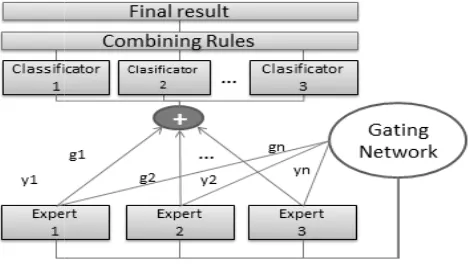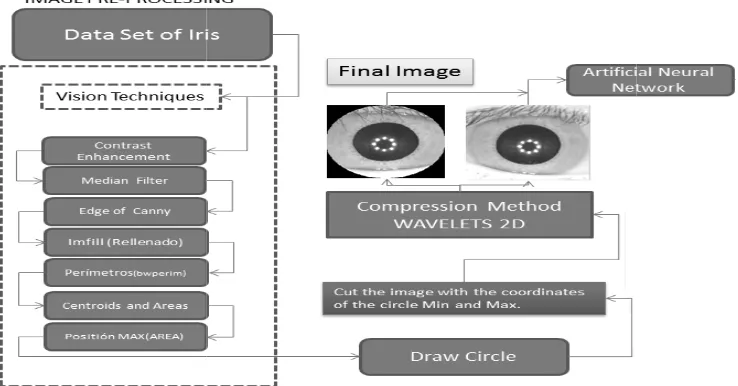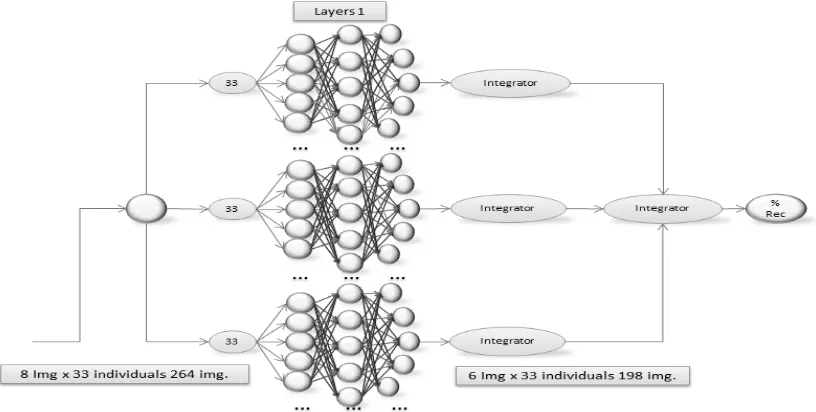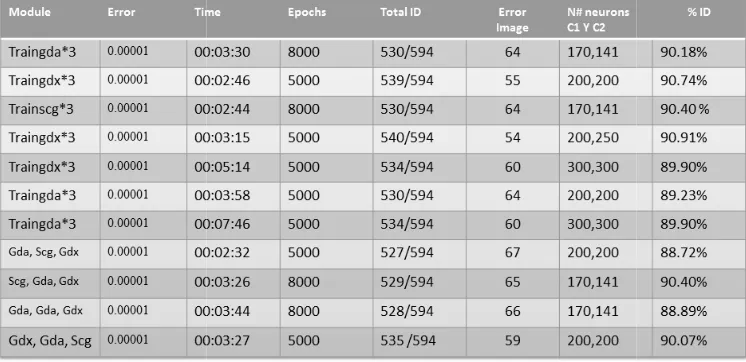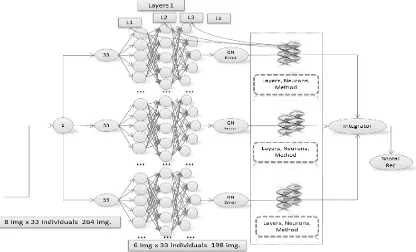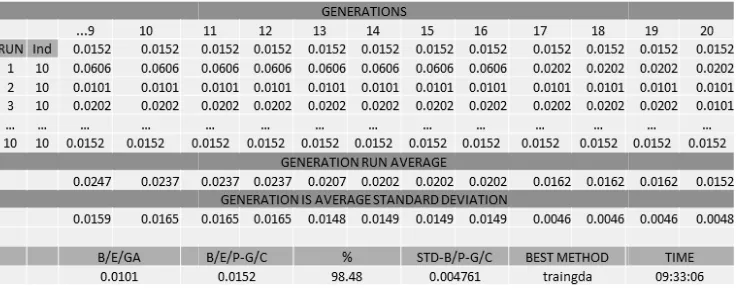ISSN: 1693-6930
accredited by DGHE (DIKTI), Decree No: 51/Dikti/Kep/2010 309
Genetic Optimization of Neural Networks for Person
Recognition Based on the Iris
Patricia Melin*, Victor Herrera, Danniela Romero, Fevrier Valdez, Oscar Castillo Tijuana Institute of Technology
Calzada Tecnologico s/n, Tijuana, mexico e-mail: [email protected]*
Abstrak
Tulisan ini menjabarkan penerapan arsitektur jaringan syaraf modular untuk kegunaan identifikasi orang menggunakan citra iris mata sebagai ukuran biometrik. Database iris mata manusia diperoleh dari Institut Automasi Akademi Ilmu Pengetahuan Cina (CASIA). Hasil simulasi ditunjukkan dengan menggunakan pendekatan jaringan syaraf modular, optimasinya menggunakan algorima genetik dan penggabungannya dengan metode lain seperti metode jaringan gerbang, integrasi fuzi tipe-1 dan penggabungan fuzi teroptimasi dengan algoritma genetik. Hasil simulasi menunjukkan tingkat indetifikasi yang bagus saat mengggunakan integrator fuzi dan struktur terbaik dimiliki oleh algoritma genetik.
Kata kunci: algoritma genetik, biometrik iris, fuzi, jaringan syaraf tiruan, optimasi
Abstract
This paper describes the application of modular neural network architectures for person recognition using the human iris image as a biometric measure. The iris database was obtained from the Institute of Automation of the Academy of Sciences China (CASIA). We show simulation results with the modular neural network approach, its optimization using genetic algorithms, and the integration with different methods, such as: the gating network method, type-1 fuzzy integration and optimized fuzzy integration using genetic algorithms. Simulation results show a good identification rate using fuzzy integrators and the best structure found by the genetic algorithm.
Keywords: fuzzy, neural networks, iris biometry, optimization, genetic algorithms
1. Introduction
The recognition of persons using biometrics is a problem that has been considered by many researchers [1-4]. Biometrics plays an important role in public safety and to accurately identify each individual to distinguish them from each other [5]. This problem has been studied more thoroughly in recent years thanks to advances in computational power that have allowed the implementation of more complex algorithms using different techniques [6], [7]. Biometric identification systems are those based on physical characteristics or morphology of human beings to perform some kind of recognition [8], [9].
Traditional systems used in accessing control are based on magnetic cards, card systems with bar code systems capture key or a combination. These systems involve the use of a card that must be carried always and which is not exempt from being lost, damaged, be stolen or forged, thus security is more vulnerable to failure. For this reason, systems that are more robust and with higher reliability are needed to avoid the problems mentioned above. Pattern recognition systems based on neural networks have been given recently considerable interest [10-15].
There are different techniques and methods that can be used for feature extraction, and today it is easier to recognize a person by the existing biometric methods. For example, a person can be recognized for its iris, fingerprints, and face, recognizable by his voice, signature, hand geometry, ear, vein structure, retina, facial thermography and others that exist [16-19]. At this moment, biometric methods have been implemented using different devices to create patterns and generate the code that identifies the persons [20-23].
attest to the uniqueness of a person from far irrepressible immutable part of the body [5]. Another definition mentions that biometrics is based on the premise that each individual is unique and has distinctive physical traits or behaviors, which can be used to identify or validate [24].
Within the large field of biometrics where one can highlight, fingerprint recognition, retinal and voice, among others, we can highlight the iris recognition as a biometric tool for person recognition in a unique and highly accurate fashion [1], [2].
This paper presents research work on integrating results of a modular neural network using the CASIA database, and obtaining the best identification when using type-1 fuzzy logic integrators developed by the genetic algorithms. Optimization of the neural networks was performed with genetic algorithms (GAs), which are essentially a method that creates a population of individuals to find the most appropriate one by simulating evolution [25-28]. This process is based on natural selection by using operators such as the crossover and mutation to create new individuals. The modular neural network architectures and the chromosomes produced by the genetic algorithms with the best parameters found for the network were tested for their performance and operation, and the results of the different integrators, such as the gating network and type-1 fuzzy logic integrators, were compared for this problem.
2. Research Method
Neural networks are composed of many elements (Artificial Neurons), grouped into layers that are highly interconnected (with the synapses), which are trained to react (or give values) in a way you want to input stimuli. These systems emulate in some way, the human brain. Neural networks are required to learn to behave (Learning) and someone should be responsible for the teaching or training (Training), based on prior knowledge of the environment problem [7], [5].
A neural network is a system of parallel processors connected together as a directed graph. Schematically, each processing element (neuron) of the network is represented as a node. These connections provide a hierarchical structure trying to emulate the physiology of the brain for processing new models to solve specific problems in the real world. What is important in developing neural networks is their useful behavior by learning to recognize and apply relationships between objects and patterns of objects specific to the real world. In this respect neural networks are tools that can be used to solve difficult problems [29], [8], [30]. Artificial neural networks are inspired by the architecture of the biological nervous system, which consists of a large number of relatively simple neurons that work in parallel to facilitate rapid decision-making [24].
Fuzzy logic was proposed for the first time in the mid-sixties at the University of California Berkeley by the brilliant engineer Lotfi A. Zadeh [31], [32]. Who proposed what it’s called the principle of incompatibility: "As the complexity of system increases, our ability to give precise instructions and build on their behavior decreases to a threshold beyond which the accuracy and meaning are mutually exclusive characteristics." Then introduced the concept of a fuzzy set, under which lies the idea that the elements on which to build human thinking are not numbers but linguistic labels. Fuzzy logic can represent the common knowledge as a kind of language that is mostly qualitative and not necessarily a quantity in a mathematical language by means of fuzzy set theory and the characteristic functions associated with them [32].
Fuzzy logic has gained a great reputation for the variety of applications, ranging from control of complex industrial processes to the design of artificial devices for automatic deduction, through the construction of household electronic appliances and entertainment as well as diagnostic systems [33-38].
Fuzzy logic is an area of soft computing, which allows one computer system to the reason for the uncertainty [31]. This corresponds, in the real world, to many situations where it is difficult to decide unequivocally whether or not something belongs to a specific class [39-42]. Fuzzy logic is a useful tool for modeling complex systems [43-48]. However, it is often difficult for human experts to define the fuzzy sets and fuzzy rules used by these systems [36]. This is particularly true for type-2 fuzzy systems that use uncertain membership functions and that have recently been applied to many real-world problems [49-57].
algorithm that transforms a se operations based on evolution be used, and after having ap (among) individuals that stand one generation to another a s operators are selection, cross being a chain of characters (l chains of chromosomes, and reflects the fitness.
There exists a divers voting method, fuzzy integrat section (for illustrative purpose
Integration by Gating tasks learned through the mo Gating Network are: best ove classifiers, need not be the sa There are several im important is by nature of using neuron to evaluate the perform gating network is based on a networks of experts [5]. In Figu
Figure 1. Repre
2.1. Iris Image Preprocessin Due to the unique, identification based on the iri The idea of using iris patt ophthalmologist Frank Burch. Safir, American ophthalmolog system, led to contact with Jo he developed the necessary a [7]. These algorithms, patente of all iris recognition systems
Various studies carrie which uses neural networks a identifier is perhaps one of t appearance of the iris. This ide
The database of huma China [58]. This institution has the database, which consists o people the total database. Th 8 images were used for trainin
set of mathematical individual objects with regard ion. The Darwinian laws of reproduction and surviva appeared of natural form a series of genetic op
nd out for the sexual recombination [25], [26]. For a series of genetic operators are applied. The mos
ssover and mutation [15]. Each of the individuals (letters or numbers) of fixed length that adjust to d one associates to them with a certain mathema
ersity of methods of integration or aggregation of ration, and gating networks [25]. However, we co
ses) on the gating network method.
ng Network: in this case decomposition of a learn modules of cooperation is performed. The benefit
verall performance, reuse of existing patterns hete same type; different features can be used for differe implementations of the modular neural networ ing the gating network. In some cases, this corres ormance of the other modules of experts. Other em
a neural network trained with a different data se igure 1 a scheme of the gating network integrator is
presentation of the gating network integration meth
ing
, stable and accessible characteristics of iris p iris pattern has become one of the most reliable atterns to identify people was first proposed ch. However, it was not until 1987, when Leonard ogists, patented the concept of Burch. His interest
John G. Daugman, then a professor at the Univers y algorithms for biometric recognition through the nted by Daugman in 1994 and partly published in [
that exist today.
rried out for iris recognition, as the work of M. Ah and the cosine transform for iris-based identificati f the most foreign to people, as among us do n identifier is one of the most accurate among biome
man iris is from the Automation Institute of the Acad has several databases of iris, and we used in this ts of 14 images per person (7 of each eye), we use The image dimensions are 320x280 pixels, the form ning and 6 for testing.
In the pre-processing noise removal, in order to extr filters on it, this in order to he images (see Figure 2).
Figure 2. Gene
Figure 3 shows the re maximum and minimum. As s outer parts of the circle, leavin of the iris, and the other way the image for the network.
Figure 3. Result of ap
Once we have all the the modular neural network, w transform 2D rate with “symml
We proceed to vecto another array of vectors with (67-99).
ng stage, different methods were applied for featu xtract the region of interest (iris) of the captured im help the modular neural network, to obtain a high
neral diagram of pre-processing for the CASIA data
resulting image, after making a cut to the image, s shown in the image this can be done in 2 ways: ving them in black and giving us a better apprecia is to let the image with their property and leaving
applying different techniques of vision to the center
he database with pre-processing and before putting , we compressed the images to 320 x 280 (25x25 mlet” of order 8, with 2 levels of decomposition (see
torize each image within a matrix containing the h the following 33 (34-66), and the last 33 persons
ture extraction and image, apply some h recognition of the
tabase
e, according to the ys: one is filling the ciation of the center ing more features in
er of the iris
ing each image into 25) using a wavelet see Figure 4). he first 33 persons,
Figure
In the first 33 persons samples of the right eye and training and 6 images to valid then you have two arrays of v validation matrix, with (8 * 33 shown in the validation matrix the modules of the modular ne
2.2. Statement of the Proble We studied several m networks for person recogni methods for response integrat the winner takes all. Figure 5 s
Figure 5.G
The modular neural multilayer perceptron, which
4. Application of the wavelet transform in 2D
ons we have 14 samples, which means that there d 7 samples of the left eye, of which we took 8 sa lidate that the images will be recognized accordin f vectors, the first containing the training images 33), 264 vectors in the matrix of training and (6 * rix. The same was done for persons (34-66) and (6 neural network.
lem and Proposed Method
methods of fuzzy integration that can be applied nition using biometric iris images as well to de ration of the modular neural network, such as the ga
5 shows the general architecture that was used in t
General architecture of the modular neural networ
al network consists of 3 modules, each modu is an artificial neural network (ANN) consisting
re are 7 pictures or sample images for ing to the 8 above, and the other the * 33), 198 images (67-99), for each of
to modular neural develop alternative gating network and
this work.
ork
and this allows you to solve matrix to represent neural ne binary vector) to a single outpu
The first module is sp 33 for the second module a network, and training is condu parameters of the (MNN) are s In this case each mod for each of the 3 modules, a are appropriate for the ANN training used. This will depen learn faster or slower and ther adapt to the learning method second and third, module, unl each module are powered b uniform. The main advantage which can be helpful because on the outcome of the integr results. The network consists step of the network, and once connections of the layers of network with the gating netw (the result of the integration of
Table 1 trainscg, which achieved a rec with a time of 3minutes and 30 8000, 5000, and 8000 epoch trainings were performed wit results were not satisfactory,
e problems that are not linearly separable. The p networks and it is a tertiary discriminator that tra tput value f (x) (a single binary value) through the m specialized for the first 33 people who were vectori
and the last 33 for the third module, forming nducted according to the sequence of modules 1st
e shown on Table 1.
odule is fed with the same information, to find a sui a study in an empirical way was done to know ho N to have a learning that is acceptable accordin end on the number of neurons used for such tra herefore have a good or bad learning, for this reaso
along with the epochs. To know which structure is nlike ensemble neural networks, modular neural n
by vectors of different data, leading to architectu ge of this method is that each module produces se the training is not leaved to one expert module. T egration, which takes into account that each mod sts of three modules, the weight distribution is ran ce this is completed the network will adjust the weig the neural network. The results of each modul twork integrator and arbitrary parameters, withou of the 3 modules), are shown in Table 2.
1. Parameters of the modular neural network
Error Epochs #Neuron
momentum and
daptive learning
0.0001 5000 y 8000 Undefin
e modular neural network without preprocessing in
sults obtained from various trainings performed that obtained a high recognition percentage were t recognition above 90%, with 90.18, 90.91 and 90.4 30 seconds, 3 minutes 15 seconds and 3 minutes chs respectively, and a target error of 0.00001 for without pre-processing and with an uncompresse
, because there are parameters that have very la
as the neurons. For this reaso rate of recognition, and thus o hidden layers, and once we ge many times the genetic algorit module of the modular neural (the result of the integration of
Table 3. Results of the
Table 3 shows the compression, which can be se same parameters of the traini traingda, traingdx, trainscg wi 50 seconds, 3 minutes 36 s epochs respectively, and a go
Figure 6.Gener
son it was chosen to use a genetic algorithm to fin obtain the appropriate type of training, the numbe get these parameters take the mean and standard orithm can find a high percentage of recognition. Th ral network with gating network integration and wi of the 3 modules) are shown in Table 3.
the Modular Neural Network in the image with prepr
e results of the trainings conducted, pre-image seen that the rates increased by almost 4% of rec ining carried out previously, the methods with high
with 95.89, 94.97 and 93.33% respectively with a seconds and 4 minutes 22 seconds, with 8000 goal error of the ANN of 0.00001.
neral architecture of optimized modular neural netw
find an appropriate ber of neurons and rd deviation of how The results of each with pre-processing
eprocessing
ge processing and recognition with the gh percentage were a time of 4minutes 00, 5000 and 5000
2.3. Optimization of the Arch To optimize the mod optimal architecture and an indicating the three modules a
Once it was verified th the GA 10 times to find the methods, and the number of obtained with the results of the with other optimization approa
3. Results and Analysis The results of execut are shown in the following Ta Table 8. The results for the o n appropriate recognition rate. The general sche s and the integrator is shown in Figure 6.
that the GA found a good optimization result, it w e standard deviation and average of the results of layers. The summary of the training behavior the 10 experiments and this forms the basis of poss roaches. The parameters of the chromosome that
me is composed of 3 layers {1, 2, 3}, and each laye over a range from 0 to 250 values and 4 trainin on Table 5.
4.Parameters of the chromosome for the GA
Layer 1
Table 5. Training for the GA
Selected Methods Scaled conjugate
Gradient descent with momentum
Gradient descent with momentum and adaptive learning fact Gradient descent with adaptive learning factor
uting 10 times the genetic algorithm (GA) for eac Tables: Module 1 in Table 6, Module 2 in Table 7 optimization of Module 1 for 10 runs of the gene
of the genetic algorithm run by generations for mo
optimization of Module 2 for 10 runs of the gene sults for the optimization of Module 3 for 10 run ble 8. In Tables 6, 7 and 8 we show the results algorithm, with 20 generations, 10 individuals and ration run and the standard deviation of each gen enetic algorithm are
execution time of the 10 runs. architectures of the different tr
Table 7. Results o
Table 8.Results
As comparison of res achieved, while in this work w that the proposed approach c 112 to 114 neurons in the thir genetic algorithm run is as fo average error of 0.0152, for th the third module of 98.59% wi integration architecture the av membership functions, the va fuzzy integrator with Gaussia average a recognition of 99.5 MFs the average recognition average recognition was 99. satisfactory, it was decided functions of this response int chosen to optimize this integr algorithm a better recognition integration system were obtain
s. Once the 10 runs of the GA were achieved, we training (150 per run).
of the genetic algorithm run by generations for mo
lts of genetic algorithm run by generations for modu
results, we can mention that in [47] a 93.33% rec we were able to obtain recognition rates of 99.76% h can outperform similar neural approaches in the
r person recognition using the iris biometric m odular neural network architectures with 3 layers in the first hidden layer, 116 and 113 in the 2nd hird hidden layer. The average percentage in each follows: for the first module, a recognition rate of
the 2nd module of 97.98%, with an average error o with an average error of 0.0141. For validation of th average was 98.48%, for the fuzzy integrator wit validation of this integrator was on average 99.3 sian membership functions, the validation of this i
.52%. In the optimized cases, for the validation w n was 99.64%, and for the validation with Gauss ained in the modular neural network.
References
[1] Bastys A, Kranauskas J, Krüger V. Iris recognition by fusing different representations of multi-scale
Taylor expansion, Computer Vision and Image Understanding. 2011; 115(6): 804-816.
[2] Boddeti VN, Kumar BV. Extended depth of field iris recognition using unrestored wave front coded
imagery, IEEE Trans. Syst., Man, Cybern. A, Syst., Humans. 2009; 40(3): 495-508.
[3] Dey S, Samanta D, Fast and accurate personal identification based on iris biometric, International Journal of Biometrics. 2010; 2(3): 250-281.
[4] Du Y, Arslanturk E, Zhou Z, Belcher C. Video-based noncooperative iris image segmentation, IEEE
Transactions on Systems, Man, and Cybernetics, Part B: Cybernetics. 2011; 41(1): 64-74.
[5] Melin P, Castillo O. Hybrid Intelligent Systems for Pattern Recognition. Heidelberg: Springer-Verlag.
2005.
[6] Chumklin S, Auephanwiriyakul S, Theera-Umpon N. Microcalcification detection in mammograms
using interval type-2 fuzzy logic system with automatic membership function generation, 2010 Proceedings of the IEEE World Congress on Computational Intelligence (WCCI 2010). Barcelona. 2010; art. no. 5584896.
[7] Gaxiola F, Melin P, López M. Modular neural networks for person recognition using the contour
segmentation of the human iris biometric measurement, Studies in Computational Intelligence. 2010;
312(1): 137-153.
[8] Sibai FN, Hosani HI, Naqbi RM, Dhanhani S, Shehhi S. Iris recognition using artificial neural
networks, Expert Systems with Applications. 2011; 38(5): 5940-5946.
[9] Zuo J, Schmid NA. On a methodology for robust segmentation of non ideal iris images, IEEE Transactions on Systems, Man, and Cybernetics, Part B: Cybernetics. 2010; 40(3): 703-718.
[10] Hidalgo D, Castillo O Melin P. Type-1 and type-2 fuzzy inference systems as integration methods in modular neural networks for multimodal biometry and its optimization with genetic algorithms,
Information Sciences. 2009; 179(13): 2123-2145.
[11] Jarjes AA, Wang K, Mohammed GJ. A new Iris segmentation method based on improved snake model and angular integral projection, Research Journal of Applied Sciences, Engineering and Technology. 2011; 3(6): 558-568.
[12] Kalka ND, Zuo J, Schmid NA, Cukic B. Estimating and fusing quality factors for iris biometric images,
IEEE Trans. Syst., Man, Cybern., A, Syst., Humans. 2009; 40(3): 509-524.
[13] Köse C, Ikibaşs C. A personal identification system using retinal vasculature in retinal fundus images,
Expert Systems with Applications. 2011; 38(11): 13670-13681.
[14] Liau HF, Isa D. Feature selection for support vector machine-based face-iris multimodal biometric
system, Expert Systems with Applications. 2011; 38(9): 11105-11111.
[15] Pimenta AHM, Camargo H. A. Interval type-2 fuzzy classifier design using genetic algorithms, 2010 IEEE World Congress on Computational Intelligence (WCCI), Barcelona. 2010: art. no. 5584520. [16] Lopez M, Melin P. Topology optimization of fuzzy systems for response integration in ensemble
neural networks: The case of fingerprint recognition, Proceedings of the Annual Conference of the North American Fuzzy Information Processing Society (NAFIPS). New York. 2008: art. no. 4531334. [17] Lopez M, Melin P, Castillo O. Comparative study of feature extraction methods of fuzzy logic type 1
and type-2 for pattern recognition system based on the mean pixels, Studies in Computational Intelligence. 2010; 312(1): 171-188.
[18] Mat Isa NA, Mamat WMFW. Clustered-Hybrid Multilayer Perceptron network for pattern recognition
application, Applied Soft Computing Journal. 2011; 11(1): 1457-1466.
[19] Melin P. Interval type-2 fuzzy logic applications in image processing and pattern recognition, Proceedings of the 2010 IEEE International Conference on Granular Computing (GrC 2010). San Jose. 2010: 728-731.
[20] Mendoza O, Melin P, Castillo O. Interval type-2 fuzzy logic and modular neural networks for face
recognition applications, Applied Soft Computing Journal. 2009; 9(4): 1377-1387.
[21] Perez C.A., Aravena C.M., Vallejos J.I., Estevez P.A., Held C.M. Face and iris localization using templates designed by particle swarm optimization, Pattern Recognition Letters. 2010; 31(9): 857-868.
[22] Lopez M, Melin P, Castillo O. Optimization of response integration with fuzzy logic in ensemble
neural networks using genetic algorithms, Studies in Computational Intelligence. 2008; 154(1):
129-150.
[23] Sánchez D, Melin P. Modular neural network with fuzzy integration and its optimization using genetic
algorithms for human recognition based on iris, ear and voice biometrics, Studies in Computational
Intelligence. 2010; 312(1): 85-102.
[24] Zeng J, Liu ZQ. Type-2 fuzzy hidden Markov models to phoneme recognition, Proceedings of the International Conference on Pattern Recognition (ICRP), Cambridge 2004: 192-195,.
[25] Chua TW, Tan WW. Genetically evolved fuzzy rule based classifiers and application to automotive
[26] Hosseini R, Dehmeshki J, Barman S, Mazinani M. Qanadli S., A genetic type-2 fuzzy logic system for
pattern recognition in computer aided detection systems, Proceedings of 2010 IEEE World Congress
on Computational Intelligence (WCCI 2010). Barcelona. 2010: art. no. 5584773.
[27] Puhan NB, Sudha N, Sivaraman Kaushalram A. Efficient segmentation technique for noisy frontal
view iris images using Fourier spectral density, Signal, Image and Video Processing. 2011; 5(1):
105-119.
[28] Sanz J, Fernandez A, Bustince H, Herrera F. A genetic algorithm for tuning fuzzy rule based classification systems with interval valued fuzzy sets, 2010 IEEE World Congress on Computational Intelligence (WCCI), Barcelona. 2010: art. no. 5584097.
[29] Fallahnezhad M, Moradi MH, Zaferanlouei S. A Hybrid Higher Order Neural Classifier for handling classification problems, Expert Systems with Applications. 2011; 38(1): 386-393.
[30] Wade JJ, McDaid LJ, Santos JA, Sayers HM. SWAT: A spiking neural network training algorithm for
classification problems, IEEE Transactions on Neural Networks. 2010; 21(11): 1817-1830.
[31] Castillo O, Melin P. Type-2 Fuzzy Logic: Theory and Applications. Heidelberg: Springer-Verlag. 2008. [32] Karnik NN, Mendel JM. An Introduction to Type-2 Fuzzy Logic Systems. University of Southern
California. Technical Report, 1998.
[33] Chen X, Li Y, Harrison R, Zhang YQ. Type-2 fuzzy logic based classifier fusion for support vector
machines, Applied Soft Computing Journal. 2008; 8(1): 1222-1231.
[34] Farouk RM. Iris recognition based on elastic graph matching and Gabor wavelets, Computer Vision
and Image Understanding. 2011; 115(8): 1239-1244.
[35] Herman P, Prasad G, McGinnity TM. Support vector-enhanced design of a T2FL approach to motor
imagery-related EEG pattern recognition, Proceedings of the IEEE International Conference on Fuzzy Systems (FUZZ 2007). London. 2007: art. no. 4295661.
[36] Herman P, Prasad G, McGinnity TM. Design and on-line evaluation of type-2 fuzzy logic system based framework for handling uncertainties in BCI classification, Proceedings of the 30th Annual International Conference of the IEEE Engineering in Medicine and Biology Society (EMBS'08), Vancouver. 2008: 4242-4245.
[37] Lucas LA, Centeno TM., Delgado MR. General type-2 fuzzy classifiers to land cover classification, Proceedings of the ACM Symposium on Applied Computing. Fortaleza, Ceará, Brazil. 2008; 1743-1747.
[38] Madasu VK, Hanmandlu M, Vasikarla S. A novel approach for fuzzy edge detection using type II
fuzzy sets, Proceedings of SPIE - The International Society for Optical Engineering. 2008; 7075(1):
art. no. 70750I.
[39] Mitchell HB. Pattern recognition using type-II fuzzy sets, Information Sciences. 2005; 170(1): 409-418.
[40] Own CM. Switching between type-2 fuzzy sets and intuitionistic fuzzy sets: An application in medical diagnosis, Applied Intelligence. 2009; 31(1): 283-291.
[41] Zhang WB, Hu HZ, Liu WJ. Rules extraction of interval type-2 fuzzy logic system based on fuzzy
c-means clustering, Proceedings of the Fourth International Conference on Fuzzy Systems and Knowledge Discovery (FSKD), Hainan. 2007: 256-260.
[42] Zheng G, Xiao J, Wang J, Wei Z. A similarity measure between general type-2 fuzzy sets and its application in clustering, Proceedings of the World Congress on Intelligent Control and Automation, Jinan. 2010: 6383-6387.
[43] Kalka ND, Zuo J, Schmid NA, Cukic B. Estimating and fusing quality factors for iris biometric images,
IEEE Trans. Syst., Man, Cybern., A, Syst., Humans. 2009; 40(3): 509-524.
[44] Qun R, Baron L, Balazinski M, Type-2 Takagi-Sugeno-Kang fuzzy logic modeling using subtractive clustering, Proceedings of the Annual Conference of the North American Fuzzy Information Processing Society (NAFIPS), Toronto. 2010: art. no. 4216787.
[45] Ren Q, Baron L, Balazinski M. High order type-2 TSK fuzzy logic system, Proceedings of the NAFIPS
2010 Conference, Toronto. 2010: art. no. 4531215.
[46] Rhee FCH, Choi BI. Interval type-2 fuzzy membership function design and its application to radial basis function neural networks, Proceedings of the IEEE International Conference on Fuzzy Systems (FUZZ), London. 2007: art. no. 4295680.
[47] Wu H, Mendel JM. Classification of battlefield ground vehicles based on the acoustic emissions,
Studies in Computational Intelligence. 2010; 304(1): 55-77.
[48] L Yu, J Xiao, G Zheng. Robust interval type-2 possibilistic c-means clustering and its application for
fuzzy modeling, Proceedings of the 6th International Conference on Fuzzy Systems and Knowledge
Discovery (FSKD), Tianjin. 2009: 360-365.
[49] Ozkan I, Türkşen IB. Entropy assessment for type-2 fuzziness, Proceedings of the IEEE International Conference on Fuzzy Systems (FUZZ), Budapest. 2004: 1111-1115.
[51] Phong PA, Thien KQ. Classification of cardiac arrhythmias using interval type-2 TSK fuzzy system, Proceedings of the 1st International Conference on Knowledge and Systems Engineering, Hanoi. 2009: 1-6.
[52] Qin K, Kong L, Liu Y, Xiao Q. Sea surface temperature clustering based on type-2 fuzzy theory, Proceedings of the 18th International Conference on Geoinformatics, Beijing. 2010: art. no. 5567484. [53] Santiago-Sanchez K, Reyes-Garcia CA, Gomez-Gil P. Type-2 fuzzy sets applied to pattern matching
for the classification of cries of infants under neurological risk, Lecture Notes in Computer Science. 2009; 5754(1): 201-210.
[54] Sharma P, Bajaj P. Performance analysis of vehicle classification system using type-1 fuzzy, adaptive neuro-fuzzy and type-2 fuzzy inference system, Proceedings of the 2nd International Conference on Emerging Trends in Engineering and Technology (ICETET), Nagpur. 2009: 581-584.
[55] Sharma P, Bajaj P. Accuracy comparison of vehicle classification system using interval type-2 fuzzy
inference system, Proceedings of the 3rd International Conference on Emerging Trends in Engineering and Technology (ICETET), Goa. 2010: 85-90.
[56] Tan WW, Foo CL, Chua TW. Type-2 fuzzy system for ECG arrhythmic classification, Proceedings of
IEEE International Conference on Fuzzy Systems (FUZZ), London. 2007: art. no. 4295478.
[57] Database of Human Iris. Institute of Automation of Chinese Academy of Sciences (CASIA). Available on the Web page: http://www.cbsr.ia.ac.cn/english/IrisDatabase.asp (2011)
